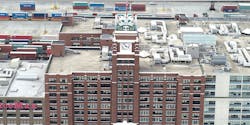Behind the $1.9 Billion Energy Savings from the Better Buildings Challenge
Since its inception, the Department of Energy’s Better Buildings Challenge has helped businesses and organizations hold themselves accountable with the goal of making buildings 20% more energy efficient. By expecting partners to measure and share energy usage data, many partners are well on their way to this goal and 18 have achieved their portfolio-wide goal.
In the 2017 Better Buildings Progress Report, the program shares its partners’ successes – namely that they have produced savings of 240 trillion BTUs and $1.9 billion in cumulative energy and cost.
One company highlighted in the report, Starbucks, saw significant improvements through power metering. Metering systems allowed Starbucks to measure the performance of equipment and customer comfort in its stores. It also used local weather conditions to set in-store temperatures and lighting, reducing utility costs by an average of 6%.
“Through the Better Buildings Initiative, hundreds of leaders from the public and private sectors are demonstrating innovative approaches and deepening American investments in critical building infrastructure,” says Secretary of Energy Rick Perry. “By planning ahead and investing in cost-effective energy efficiency strategies, partners are bringing better buildings to our communities and improving the everyday places Americans live and work, while creating new and lasting jobs.”
The report also commended the Wendy’s Company for its benchmarking efforts, as it began actively recruiting franchisees to join the Better Buildings Challenge. For those that joined, Wendy’s offered technical and benchmarking support through a third party to support franchisees with energy efficiency. One such franchisee now features all LED lighting and efficient HVAC equipment, which has yielded significant energy savings.
Moreover, the program has helped boost the widespread adoption of metering practices. Two of the Better Buildings Challenge’s specific actions include:
- Holding an Energy Management Information Systems workshop with over 30 program stakeholders. Hosted by Lawrence Berkeley National Laboratory, participants learned more about submetering, occupant engagement and M&V 2.0.
- The Berkeley Lab’s Center of Expertise for Energy Efficiency in Data Centers published metering guidance that helps data center operators identify what they need to make better energy efficiency decisions for their facilities.
To read the report, visit betterbuildingsinitiative.energy.gov.
